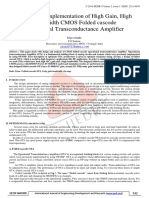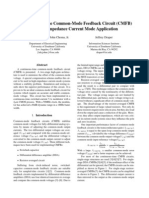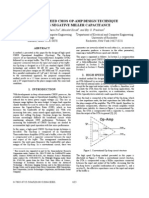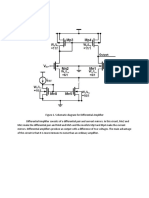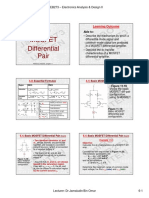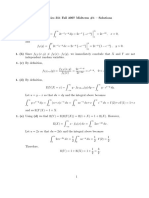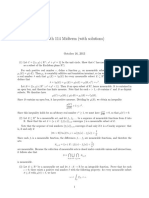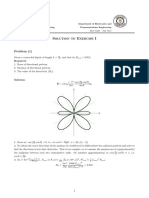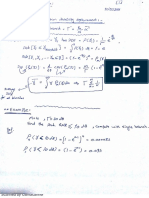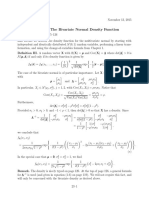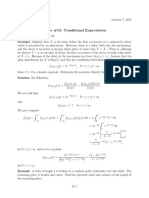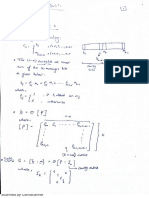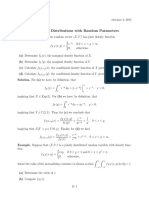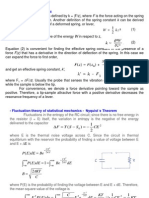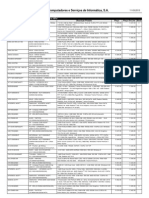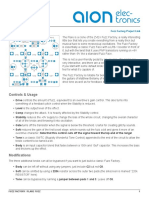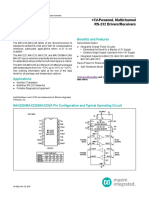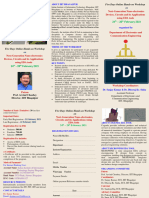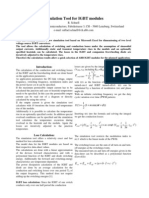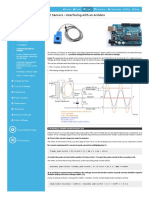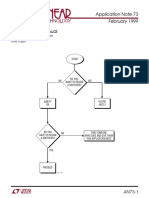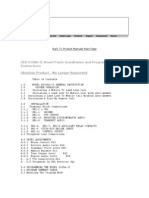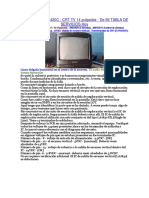ECEN474: (Analog) VLSI Circuit Design
Fall 2012
Lecture 17: Fully Differential Amplifiers & CMFB
Sam Palermo
Analog & Mixed-Signal Center
Texas A&M University
�Announcements & Agenda
Preliminary report due 11/19
Fully differential circuits
Common-mode feedback circuits
�TAMU-Elen-474
Jose Silva-Martinez-08
Basic Operational Transconductance Amplifier Topologies
vO
vI+
io
M1
M2
SINGLE-ENDED
vI-
vI-
M1
M2
v I+
vO
io
ITAIL
ITAIL
(a)
v O+
vI+
(b)
M1
M2
ITAIL
IB
v I-
vO-
v I+
vO +
M1
M2
ITAIL
IB
(c)
FULLY-DIFFERENTIAL
-3-
(d)
vI -
v O-
�TAMU-ECEN-474
Jose Silva-Martinez_08
Fully-Differential Circuits
In general:
vin1
vo1
vo1 vo 2 vo1 + vo 2 vod
vo1 =
+
=
+ voc
2
2
2
- +
+vin2
vo 2 vo1 vo1 + vo 2
vod
vo 2 =
+
=
+ voc
2
2
2
vo2
Hence
v od A dd A dc v id
v = A
oc cd A cc v ic
Common-mode output
Differential-mode output
A dd =
v od
v id
A dc =
Vic =0
v od
v ic
Vid =0
A cd =
-4-
v oc
v id
A cc =
Vic =0
v oc
v ic
Vid =0
�TAMU-ECEN-474
Jose Silva-Martinez_08
Fully-Differential Filters: Effects of current source inpedance and mismatches
vin1
vo1
A very important parameter:
- +
+vin2
CMRR =
A dd
A dc
vi 2 + vi1
w/ vid = vi 2 vi1 and vic =
2
vo2
Solving the circuit:
Example:
IB
IB
v02
v01
Z1
v1
v2
M1
M2
g m1 g m 2 Z1
v01 =
g m1 + g m 2 + Ys
Z2
v02 =
2IB
g m1 g m 2 Z 2
g m1 + g m 2 + Ys
Ys
Ys
vid
vic
1 +
gm2
2 g m 2
Ys
Ys
vic
v
1
id
g m1
2 g m1
Ys is the admittance associated with the current source 2IB
-5-
�TAMU-ECEN-474
Jose Silva-Martinez_08
Fully-Differential Filters: Non-idealities
Voltage gain: Note the effects of the
mismatches, especially in Adc and Acd
IB
IB
v02
v01
Z1
v1
v2
M1
Add =
vo1 vo 2
vi 2 vi1
=
vic = 0
g m1 g m 2
g m1 + g m 2 + Ys
Ys
Z1 + Z 2 +
2
Z1
Z
+ 2
g m 2 g m1
Z2
M2
2IB
Adc =
vo1 vo 2
(vi 2 + vi1 ) 2 v
id
Z
g m1 1 + 1
A
Z2
CMRR = dd
Adc
g Z
Ys 1 m1 1
gm2 Z 2
Acd =
Acc =
vi 2 vi1
vic = 0
(vo 2 + vo1 ) 2
(vi 2 + vi1 ) 2 v
id
-6-
g m1 g m 2
g m1 + g m 2 + Ys
g m1 g m 2
Y
1
Z1 Z 2 + s
g m1 + g m 2 + Ys 2
2
=0
(vo 2 + vo1 ) 2
=
=0
Z2
Z1
Y
s
g
g
m 2
m1
Z1
Z
2
g m 2 g m1
g m1 g m 2
Z
1 Z 2
+ 1
Ys
g m1 + g m 2 + Ys 2 g m1 g m 2
�TAMU-ECEN-474
Jose Silva-Martinez_08
Fully-Differential Circuits
Ideal voltage gain
ZF
vin1
vin2
Z1
Add =
Zf
v01 v02
=
vin 2 vin1
Z1
vo1
- +
Ideally even-order distortions are cancelled
+-
Ideally common-mode signals are rejected
Z1
ZF
vo2
What sets the output common-mode of these circuits?
Function of the amplifier output resistance
ZF
vin1
vin2
Z1
Z1
Common-mode offsets can impact the
vo1
- +
performance of the following stages
+-
Can exceed the common-mode input
ZF
range of preceeding stages
vo2
IB
With finite Acc can accumulate in a
multi-stage amplifier circuit
-7-
�TAMU-ECEN-474
Jose Silva-Martinez_08
Fully-Differential Amplifiers: COMMON-MODE DC offset
If IB is positive transistors M3 eventually will be
biased in triode region (small resistance)
M3
IB+IB
dc gain reduces drastically
M3
Vb
Linear range is further minimized
IB+IB
v01
v02
v1
Z1
v2
M1
M1
2IB
Z1
THD increases
The common-mode output impedance is the
parallel of the equivalent output resistance (M1 and
M3) and the parasitic capacitors.
For large dc gain, the output impedance at nodes
v01 and v02 are further increased and IB produces
a dc offset = RoutIB.
Large common-mode offsets!
How can this issue be fixed?
-8-
�TAMU-ECEN-474
Jose Silva-Martinez_08
Fully-Differential Amplifiers: Characterization
Common-mode current offset of 0.01 mA
per side is added on purpose
Tail current is 0.5 mA while the current
sources on top are 0.26 mA!
Differential input voltage is set at 0
-9-
�TAMU-ECEN-474
Jose Silva-Martinez_08
Fully-Differential Amplifiers: Characterization
Offset current is integrated, and output
voltage moves upstairs and reach steady
state when the current sources on top
become equal to 0.25 mA!
Differential input voltage is set at 0
- 10 -
�TAMU-ECEN-474
Jose Silva-Martinez_08
Fully-Differential Amplifiers: Common-mode Feedback
Adder
CM-Feedback
Gcmf=100 A/V.
If the current offset is 10 A, then the
offset voltage needed for compensation is
100 mV.
Expected DC outputs after settling are
100 mV.
- 11 -
�TAMU-ECEN-474
Jose Silva-Martinez_08
Fully-Differential Amplifiers: Common-mode Feedback
Gcmf=100 A/V.
If the current offset is 10 A, then the
offset voltage needed for compensation is
100 mV.
Expected DC outputs after settling are
100 mV.
If necessary to reduce this 100mV offset
further, then use a larger Gcmf
- 12 -
�TAMU-ECEN-474
Jose Silva-Martinez_08
What is a common-mode feed-back
correction circuit ?
A common mode feed-back circuit is a
circuit sensing the common-mode voltage,
comparing it with a proper reference, and
feeding back the correcting common-mode
signal (both nodes of the fully-differential
circuit) with the purpose to cancel the
output common-mode current component,
and to fix the dc outputs to the desired level.
- 13 -
�TAMU-ECEN-474
Jose Silva-Martinez_08
Fully-Differential Filters: CMFB Principle
A common-mode feedback loop must be used:
Circuit must operate on the common-mode
signals only!
ZF
Z1
vin1
vo1
BASIC IDEA: CMFB is a circuit with very
small impedance for the common-mode signals
but transparent for the differential signals.
- +
+Z1
vin2
ZF
vo2
Use a common-mode detector (eliminates the
effect of differential signals and detect commonmode signals)
Simplest common-mode detector
vcm
vo1
vo2
v cm =
v 01 + v 02
2
Analyze the common-mode feedback loop:
Large transconductance gain and enough phase
margin
Minimum power consumption
- 14 -
�TAMU-ECEN-474
Jose Silva-Martinez_08
CMFB Principles: Analysis of the loop for common-mode signals only
Analysis for common-mode noise; for instance noise
due to power supplies:
io1=io2=icm_noise
icm_noise
(1/2)
vocm -
The two outputs can be connected together for the
analysis of the CMFB loop!
Gm_fb
Vref
(define the
commonmode level)
icm_noise
BASIC CONCEPTS:
Effect of common-mode noise:
1
Zcm=
vcm_noise = icm_noise/Gm-fb
gm
common-mode voltage variations
vcm_noise=icm_noise/Gm_fb !!
icm_noise
The common-mode input noise is converted into a
common-mode voltage (common-mode voltage
noise) by the common-mode transconductance of the
CMFB =1/Gm_fb.
Gm_fb
The larger Gm_fb the smaller the effects
of the common-mode noise!
vref
- 15 -
�TAMU-ECEN-474
Jose Silva-Martinez_08
Fully-Differential Filters: CMFB
M3
M3
IB
v01
IB
v1
Z1
Control
CMFB Characteristics:
v02
Transconductance gain=gm2/2
mirror in CMFB OTA)
v2
M1
M1
(no PMOS
dominant pole at the output
Z1
At least 2 additional poles in the loop
2IB
Zcm reduces the OTA dc gain, affecting the
differential gain
Zcm
Zcm
M3
Vcm
M2
M3
NOTE THAT Vcm IS FORCED TO BE
AROUND THE GROUND LEVEL.
GND
DC OFFSET VOLTAGE IS
AROUND 2*Ioff/gm2
M2
2IB
CMFB
- 16 -
�TAMU-ECEN-474
Jose Silva-Martinez_08
Fully-Differential Filters: CMFB
2M3
voc
CMFB Characteristics:
i3
Loop
DC Transconductance gain=gm2/2
0.5 Z1
2M1
Loop gain (ignoring poles)
g Z
Z
g 1
( 2 g m 3 ) 1 = m 2 1
m 2
2
2
2 g m 3
Zcurrent_sourc
e
dominant pole at the output
At least 2 additional poles in the loop
0.5Zcm
M3
M3
DC OFFSET IS AROUND 2Ioff/gm2
GND
Vcm
M2
M2
2IB
CMFB
- 17 -
�TAMU-ECEN-474
Jose Silva-Martinez_08
Fully-Differential Filters: CMFB Principles
Can be removed
for CMFB
analysis
M3
IB
v01
IB
v1
Z1
Common-mode stability: DC gain and
most relevant poles
M3
v02
1 pole at vcm (1/RC)
1 pole at gate of M3 (gm3/CP3)
1 pole at the output (g01/C1)
v2
M1
M1
Z1
dc gain = 0.5 gm2R01
Dominant pole
2IB
Zcm
GBW
Zcm
M3
M3
Vcm
First non-dominant
pole
ground
M2
M2
2IB
CMFB
- 18 -
Be sure phase margin > 45
�TAMU-ECEN-474
Jose Silva-Martinez_08
OPAMP
Mp
IB(vC)
IB(vC)
R
v1
v01
R
vC
v2
Mp
v02
v1
Mp
Mp
CL
.
.
v2
Mn
2IB
CMFB
Mn
CL
AC
GND
vC
Mcm
Mcm
2IB
2IB
(a)
(b)
Fig. 3 Common-mode feedback basic circuit concept. (a) Basic common-mode
detector, (b) A CMOS CMFB Implementation.
Notice that the resistors R reduce the differential gain!
- 19 -
�TAMU-ECEN-474
Jose Silva-Martinez_08
Fully-Differential Amplifiers: Common-mode pulse
Differential Time Constant=5K*10P=50nsecs
A pulsed current is added to the tail
current (common-mode pulse)
This current must be absorbed by the
CMFB
Differential feedback does not reduce
common-mode offsets and noise.
- 20 -
�TAMU-ECEN-474
Jose Silva-Martinez_08
Fully-Differential Amplifiers with CMFB
Differential input signals only
Settling time
Single-ended outputs
Seems to be that the system
is working fine, isnt it?
- 21 -
�TAMU-ECEN-474
Jose Silva-Martinez_08
Fully-Differential Amplifiers with CMFB
Differential input signals + common-mode pulses
Single-ended outputs
- 22 -
�TAMU-ECEN-474
Jose Silva-Martinez_08
Fully-Differential Amplifiers with CMFB
Differential input signals + common-mode pulses
Common-mode output
True pulse response of the CMFB
Evidently PM<45 degrees
GBW ~ 1/0.8us=1.2 MHz
DC-CMFB resistance ~ 10mV/Ioffset
- 23 -
�TAMU-ECEN-474
Jose Silva-Martinez_08
Fully-Differential Filters: Adding buffers to handle the resistive CM-detector
v01
The stability conditions are exactly the
same for OTAs and OPAMPs:
M3
M3
IB
IB
Z1
v02
1 pole at vcm (1/RC)
1 pole at gate of M3 (gm3/CP3)
1 pole at the output (g01/C1)
In OPAMPs you can use resistors as
common-mode detector due to the presence
of the output buffers
dc gain = 0.5gm2R01
Z1
M1
M1
2IB
Zcm
Dominant pole
Zcm
M3
M3
GBW
Vcm
ground
M2
M2
2IB
CMFB
- 24 -
First non-dominant
pole
�Isolated Common-Mode Sensing
Source-Followers
isolate the loading of
the common-mode
sensor resistors
[Gray]
Need to have a
replica source
follower to set the
appropriate reference
level for the CMFB
amplifier
25
�Two Differential Pair CM Sensor
[Gray]
I cms = I 20 + g m 22 (Voc VCM )
Gcmf = g m 22
26
�CMFB w/ Triode Devices
in Tail Current Source
[Razavi]
27
�Next Time
OTA CMFB Examples
Output Stages
28





